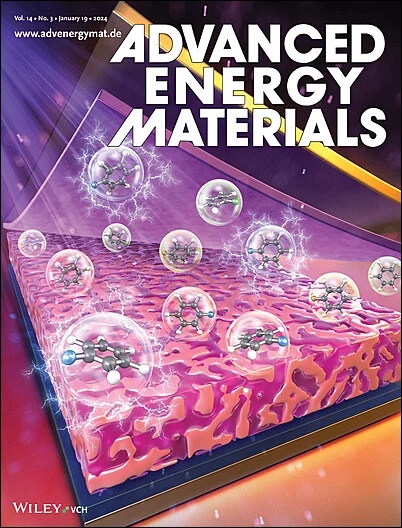2D p-Block Main Group Phthalocyanine Monolayers
IF 26
1区 材料科学
Q1 CHEMISTRY, PHYSICAL
引用次数: 0
Abstract
A large class of novel 2D p-block main group phthalocyanine (mgPc) monolayers is discovered for the first time via systematic first-principles calculations and molecular dynamics simulations. 21 newly uncovered semiconductors exhibit exceptional carrier mobility (up to 106 cm2 V−1 s−1) and exceed reported values. Axially ligands, biaxial strains, and central atoms are three important degrees of freedom for tuning the properties of the mgPc series. Axially ligands can modulate properties comprehensively, e.g., inducing metal-to-semiconductor transitions and enhancing mobility. Compressive strains gestate 8 Dirac materials featuring three different cone types. Biaxial strain yields diverse semiconductors spanning wide bandgap spectra (0−1.59 eV at HSE06) and conforming to the newly proposed “unimodal model”. The designed semiconductor library provides donor/acceptor candidates for solar cells with record power conversion efficiencies (PCE = 26.28% of PClPc/P(OH)Pc). Solid state adaptive natural density partitioning (SSAdNDP) analysis revealed the presence of electron delocalization within the 16-membered ring of phthalocyanine (16c-2e π-bond), which is unprecedented in 2D materials. The great tunability and high stability of mgPc monolayers pave the way toward diverse applications in flexible electronics, optoelectronics, solar cells, and light harvesting. It is hoped that the work can stimulate the experimental fabrication of these exciting 2D materials.

二维p-阻滞主基酞菁单分子膜
通过系统的第一性原理计算和分子动力学模拟,首次发现了一类新的二维p-嵌段主基酞菁(mgPc)单层膜。21新发现的半导体表现出优异的载流子迁移率(高达106 cm2 V−1 s−1),超过了报道的值。轴向配体、双轴应变和中心原子是调节mgPc系列性能的三个重要自由度。轴向配体可以全面调节性质,例如,诱导金属到半导体的转变和增强迁移率。压缩应变孕育了具有三种不同锥型的8种狄拉克材料。双轴应变产生不同的半导体,跨越宽的带隙光谱(0−1.59 eV在HSE06),并符合新提出的“单峰模型”。所设计的半导体库为太阳能电池提供了供体/受体候选体,具有创纪录的功率转换效率(PCE = PClPc/P(OH)Pc的26.28%)。固态自适应自然密度分配(SSAdNDP)分析显示,酞菁16元环(16c-2e π键)内存在电子离域,这在二维材料中是前所未有的。mgPc单层材料的高可调节性和高稳定性为其在柔性电子、光电子、太阳能电池和光收集等领域的广泛应用铺平了道路。希望这项工作能够促进这些令人兴奋的二维材料的实验制造。
本文章由计算机程序翻译,如有差异,请以英文原文为准。
求助全文
约1分钟内获得全文
求助全文
来源期刊

Advanced Energy Materials
CHEMISTRY, PHYSICAL-ENERGY & FUELS
CiteScore
41.90
自引率
4.00%
发文量
889
审稿时长
1.4 months
期刊介绍:
Established in 2011, Advanced Energy Materials is an international, interdisciplinary, English-language journal that focuses on materials used in energy harvesting, conversion, and storage. It is regarded as a top-quality journal alongside Advanced Materials, Advanced Functional Materials, and Small.
With a 2022 Impact Factor of 27.8, Advanced Energy Materials is considered a prime source for the best energy-related research. The journal covers a wide range of topics in energy-related research, including organic and inorganic photovoltaics, batteries and supercapacitors, fuel cells, hydrogen generation and storage, thermoelectrics, water splitting and photocatalysis, solar fuels and thermosolar power, magnetocalorics, and piezoelectronics.
The readership of Advanced Energy Materials includes materials scientists, chemists, physicists, and engineers in both academia and industry. The journal is indexed in various databases and collections, such as Advanced Technologies & Aerospace Database, FIZ Karlsruhe, INSPEC (IET), Science Citation Index Expanded, Technology Collection, and Web of Science, among others.
 求助内容:
求助内容: 应助结果提醒方式:
应助结果提醒方式:


